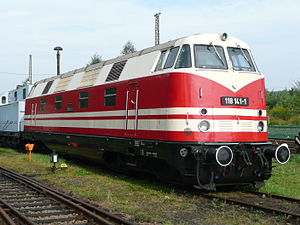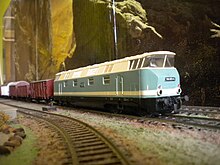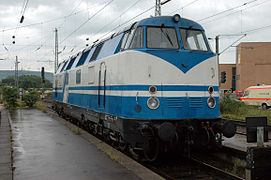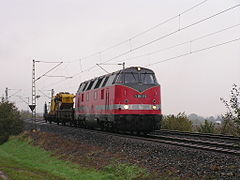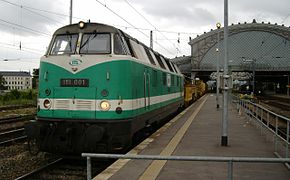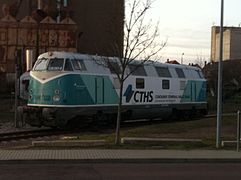DR series V 180
| DR series V 180 Leuna 201–205, Buna 201–204 |
|||||
|---|---|---|---|---|---|
| Manufacturer: | Lokomotivbau Karl Marx Babelsberg | ||||
| Number: | 2 + 85 | Conversion from 118.0 | 82 | 206 | Conversion from 118.2–4 |
| Numbering: |
V 180 001-087 118 003-087 - |
- 118 503… 587 228 505… 586 |
V 180 101–182 118 101–182 228 104… 182 |
V 180 201–399 118 201–406 228 203… 390 |
- 118 601… 806 228 601… 806 |
| Axis formula: | B'B ' | C'C ' | |||
| Years of construction: | 1960-1966 | 1966-1970 | |||
| Retirement: | until 1995 (at DB AG) | ||||
| Service mass: | 78.0 t | 79.3 t | 78.7 t | 93.6 t | 95.0 t |
| Axle travel mass: | 19.5 t | 19.8 t | 19.7 t | 15.5 t | 15.6 t |
| Motor type: | 12KVD21 A-2 | 12KVD21 A-3 | 12KVD21 AL4 | ||
| Motor type: | 2 × 12-cylinder V-engine with exhaust gas turbocharger | 2 × 12-cylinder V-engine with exhaust gas turbocharger and intercooler | |||
| installed capacity: | 2 × 662 kW (2 × 900 PS) |
2 × 736 kW (2 × 1000 PS) |
2 × 883 kW (2 × 1200 PS) |
||
| Starting tractive effort: | 228 kN | 255 kN | 230 kN | 270 kN | |
| Continuous tensile force: | 124 kN | 160 kN | 163 kN | 154 kN | 178 kN |
| Power transmission: | hydrodynamic | ||||
| Length over buffers: | 19,460 mm | ||||
| Width: | 3,020 mm | ||||
| Height: | 4,282 mm | ||||
| Trunnion Distance: | 12,200 mm | 10,910 mm | |||
| Bogie axle base: | 3,400 mm | 3,600 mm | |||
| Wheel diameter: | 1,000 mm | 1,050 mm | |||
| Top speed: | 120 km / h | ||||
| Train heating: | Steam boiler type "Köthen" | ||||
| Brakes | Indirect, single-release, automatic single-chamber air brake with high braking ( Knorr type ) + additional brake | ||||
The class V 180 of the Deutsche Reichsbahn (from 1970 class 118 , later DB class 228 ) was the largest diesel locomotive built in the GDR . The manufacturer was Lokomotivbau Karl Marx Babelsberg (LKM).
The V 180 was intended to accelerate the change of traction on the Deutsche Reichsbahn and therefore replace various steam locomotive series in use on main lines.
history
In 1953 the Deutsche Reichsbahn commissioned the Association of Nationally Owned Enterprises of Locomotive and Wagon Construction (LOWA) with the development of modern diesel vehicles.
After the first drafts were submitted in 1956, a concept was presented in 1957 that provided locomotives with engines of 1,800 HP and 2,000 HP for heavy passenger and freight train service on main lines.
Prototypes
In 1959, LKM completed the two advance locomotives V 180 001 and 002 with the B'B 'wheel arrangement. Since the GDR industry was not yet able to produce all the components for a large diesel locomotive that it had developed itself, the locomotives had a Voith gearbox and were delivered without a boiler. They had multiple controls from Brown, Boveri & Cie. These locomotives were not taken over by the DR and were scrapped at the Babelsberg plant in 1965 and 1966. Among other things, they were too heavy.
V 180.0
In 1961 the state planning commission approved the funds for the construction of 128 machines. Two more advance locomotives (V 180 003 and 004) were built in 1962. The electrical equipment for these came from LEW in Hennigsdorf. This was followed by a small series of five locomotives and the first series production up to the V 180 087 in the years 1963–1965. The locomotives received two 12-cylinder - short stroke - four-stroke - Diesel engines of the type 12 KVD 18/21 AI in V-arrangement with a displacement of approximately 74.8 liters and a rated power of 662 kW (900 hp) from VEB engine plant Johannistal .
V 180.1
From 1965, more powerful engines with 736 kW (1000 hp) were installed. To distinguish them, these locomotives were called V 180.1. From 1983 three of these locomotives even received engines with 900 kW and 1050 kW.
V 180.2
A version with the C'C 'wheel arrangement was developed for use on branch lines. In 1964 the V 180 201 was completed with two 662 kW (900 PS) engines. From 1966, after extensive testing, a total of 205 locomotives with two 736 kW (1000 hp) engines followed from V 180 203, the last of which were delivered under the new series designation 118. From the V 180 298 onwards, a fluid transmission from the GDR production by VEB Turbinenfabrik Dresden could be installed.
V 180.5
From 1979 to 1987 52 locomotives of the first series were equipped with new, 12 KVD 18/21 A-3 (736 kW / 1000 PS). In seven locomotives, the engine was even set to 900 kW (1200 hp). The converted locomotives were redesignated as the class 118.5 from 1981.
118.6
From 1981 to 1989, 179 locomotives of the 118.2–4 series were equipped with 883 kW (1200 hp) engines during scheduled investigations; they also received an order number increased by 400.
construction
The locomotive has a lightweight frame. It was initially built in a version with two two-axle bogies. Since the power from the gearboxes located under the driver's cabs could best be transmitted to the bogies at the point where the pivot pins would be, this variant had no pivot pins. Instead, the bogies were attached to the frame by means of a lever system (trapezoidal strap linkage). The primary suspension consisted of rubber compression springs with metal interlayers, the secondary suspension of leaf springs.
The locomotive had a Köthen type boiler in the middle , which was also used in the DR series V 100 . The water tanks and the cooling systems for the two diesel engines, which were located behind the driver's cabs, were arranged around this. The three-converter fluid transmission for 120 km / h from the Austrian subsidiary of Voith in St. Pölten are located under the high driver's cabs . The alternators and fan generators are flange-mounted here. The compressors driven by electric motors are also located under the driver's cabs. The control cabinets are arranged on the rear walls of the driver's cabs.
The six-axle version was equipped ex works with the further developed engines 12KVD18 / 21-A3 with 736 kW (1000 PS). When the engine was replaced later, all machines were given the even more powerful version 12KVD18 / 21-AL4 with 883 kW (1200 hp). The three-axle bogies have pivot pins. The six-axle machines only had two engine room windows compared to the four of the four-axle locomotives, the outer windows had been replaced by multiple-nozzle ventilation grilles.
As an experiment, highly charged engines of the type 12KVD18 / 21-AL5, each with 1100 kW (1500 PS) drive power, were installed in the 1980s. Since the engines that were in the test phase were unreliable and the 132 and 119 series had correspondingly powerful locomotives at their disposal, a series conversion was refrained from.
From 1968 - starting with the V 180 300 - fluid drives from VEB fluid machines Pirna were installed.
At DB AG, the locomotives were run as the 228 series.
Types
- Model locomotives 001 and 002 (remained the property of the manufacturer, were later dismantled)
- Pre-series: 003 and 004 (later adapted to the series version)
- Small series: 005 to 009
- The locomotives 059, 131 and 203 were given a glass fiber pulpit with an angular design and a glare-free pane to give the locomotive a "representative appearance". (203 later adapted to the standard version)
- Nine factory locomotives from the manufacturer's works with a changed gear ratio (top speed 100 km / h (Buna) and 85 km / h (Leuna)) and without heating at Leuna and Buna factories.
Sub-series
- 118.0 - four-axle version, 2 × 662 kW (900 PS), 120 km / h
- 118.1 - four-axle version, 2 × 736 kW (1000 PS), 120 km / h
- 118.2–4 - six-axle version, 2 × 736 kW (1000 PS), 120 km / h
- 118.5 - four-axle version, converted from 118.0, 2 × 736 kW (1000 PS), 120 km / h
- 118.6–8 - six-axle version, converted from 118.2–4, 2 × 883 kW (1200 PS), 120 km / h
- 118 405 - six-axle version, 2 × 1030 kW (1400 PS) (2 × diesel engines of type 12 KVD 18/21 AL-4, gearbox GSR 20 / 5.5 (1980) / GSR 30 / 5.7 (1984))
- 118 625 - six-axle version, 2 × 1104 kW (1500 PS) (2 × diesel engine type 12 KVD 18/21 AL-4, gearbox GSR 30 / 5.7)
- 118 124 - four-axle version, 2 × 1104 kW (1500 PS) (2 × diesel engine type 12 KVD AL 5, gearbox GSR 30 / 5.7 mod.), 120 km / h
V 180 046 on June 9, 1967 in Halle-Neustadt
118 173-4 in Dresden Central Station , 1972
V 240 001
In 1965 the prototype of a six-axle locomotive with two engines with 883 kW (1200 hp) was presented at the Leipziper spring fair. The maximum speed of this locomotive was 140 km / h. The superstructures corresponded to the V 180, but the driver's cabs were made of fiberglass-reinforced polyester resin (GfP) and the paint was silver-gray. Trials took place until 1968, despite good tractive power, series production was not carried out. After a long period of storage, the locomotive, which had previously belonged to LKM, was acquired by the Deutsche Reichsbahn, and adapted to the standard version in the Neustrelitz depot using accident locomotives, and the top speed was also reduced to 120 km / h. It was then listed as 118 202.
use
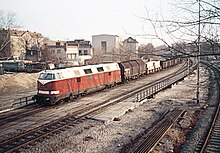
Until the delivery of the large Soviet diesel locomotives of the 130 series , the V 180 were mainly used in express train traffic. This also included the use in transit traffic from West Berlin to the Federal Republic. This series was regularly used in plans for which it was not actually designed, e.g. B. in front of heavy express trains that were otherwise hauled by class 01 , 01.5 , 03 and 03.10 steam locomotives . The 118.2–4 (.6–8) series was universally applicable, as it could also be used on branch lines with a lighter superstructure with an axle load of 15.6 tons . This sub-series is also approved for steep sections . The use of this series in passenger traffic ended with the exclusive use of passenger coaches with electrical power supply by means of a train bus instead of the older coach types with steam heating ; similar to the 110/112 series . In addition, traffic ceased on most of the steep stretches, making vehicles unnecessary. In 1995 the last copies of the 228.2–4 were withdrawn from service at DB AG; some of the 228.6–8 were kept until June 10, 1998.
Three locomotives, the 118 548, 550 and 552, were assigned to the GDR government train. The locomotives were in operation in April 1990 between Berlin-Wannsee and Potsdam Hbf in cross-border S-Bahn advance traffic. The 118 552 is the last operational locomotive of the ITL and has been in service there again since 2015 as the 118 552 in the old red paint scheme. 118,548 and 550 were sold in 1992; the latter was scrapped in Neumark (Sachs) in 2003. On October 28, 2000, 118 548 had a serious accident in Haspelmoor, so that it could no longer be repaired and was later scrapped in Altenbeken as well.
A whole series of locomotives could be sold to private railways, some of which continued to serve for many years. However, the age of the operating time set limits, and the operating costs are higher than with single-engine locomotives and the stricter exhaust gas limits made retrofitting necessary.
As recently as 2005, some locomotives were used by the Mitteldeutsche Eisenbahn (MEG, an 80% subsidiary of DB Cargo Deutschland AG) on the routes around Saalfeld / Saale and Bad Lobenstein , as difficulties repeatedly occurred with other series. The last operational V 180 (MEG 206) at MEG was parked in April 2015 and handed over to the railway museum in Wittenberge. The other MEG locomotives are parked or are on loan to railway associations. Some other private railways still use this robust series.
The six-axle Leuna (now InfraLeuna) 204 and 205 were sold to the ITB railway company. Of these, the former InfraLeuna 205 is operational. Most of them come from the DR inventory. In 2015, nine of the 42 remaining machines were still operational, in 2018 there were only six.
ITL 118 001 with track construction train in the station Dresden-Neustadt
118 586 in the traditional Staßfurt depot
BR 228 of the Halle (Saale) container terminal (CTHS) on the tracks of the Halle-Trotha port railway
Preservation in a museum
- 118 075: in the German Museum of Technology in Berlin , last operating condition, largely original
- 118 118: Museum Bw Schwerin
- 118 119: Museum Bw Lutherstadt-Wittenberg, private
- 118 141: Museum Bw Chemnitz-Hilbersdorf
- 118 202: as V 240 001 Dresden Transport Museum
- 118 505: was the first series locomotive as V 180 005, Museum Bw Arnstadt
- 118 578: Museum Bw Weimar
- 118 585: Entrance to the ITL premises in Pirna
- 118 586: Museum Bw Staßfurt
- 118 617: Tuttlingen Railway Museum
- 118 683: at the Ostsächsische Eisenbahnfreunde e. V. in Löbau (Sachs) station on loan from the DB Museum Nuremberg (until 2022)
- 118 692: Historic Wittenberge engine shed
- 118 731: Museum Bw Weimar
- 118 748: Historic locomotive shed in Wittenberge
- 118 749: Museum Bw Arnstadt
- 118 770: Museum Bw Glauchau
- 118 776: Museum Bw Schwarzenberg
- 118 782: Museum Bw Chemnitz-Hilbersdorf
- 118 788: Museum Bw Weimar
- 118 791: Ostsächsische Eisenbahnfreunde eV
- 118 802: Museum Bw Leipzig Süd / DB Museum Halle (Saale)
- BUNA 201: Museum Bw Gera
- BUNA 202: Museum Bw Staßfurt
- BUNA 203: Museum Bw Weimar
Individual evidence
- ^ Klaus-Jürgen Halle: The large diesel locomotive V 180 - the successful model from Babelsberg. In: The Deutsche Reichsbahn - 45 years of railway history in the GDR, chapter 5.2, issue 1/2012, Geramond-Verlag, Gilching
- ↑ Michael Kratzsch-Leichsenring: Technical eccentrics: V 180 locomotives for industry . In: Eisenbahn Magazin . No. 6 , 2018, p. 16 .
- ↑ Dirk Endisch: Power pack without a future . In: Eisenbahn Magazin . No. 4 , 2018, p. 17 .
- ↑ Video, see from 3:50
- ↑ 275050 - The V180 of the Deutsche Reichsbahn. In: www.v180-online.de. Retrieved September 30, 2016 .
- ↑ 275048 - The V180 of the Deutsche Reichsbahn. In: www.v180-online.de. Retrieved September 30, 2016 .
- ^ Received V 180
- ↑ Dirk Endisch, Michael Kratzsch-Leichsenring: Private railways used themselves . In: Eisenbahn Magazin . No. 6 , 2018, p. 19 .
- ↑ 118 683-2 at OSEF e. V.
literature
- Hans-Jürgen Barteld: The 118 on Thuringian rails - the locomotive series between express trains and steep sections. Berga / Elster 2005, ISBN 3-935961-07-3 .
- Konrad Koschinski: The V 180 of the DR. Eisenbahn-Journal, special edition 3/2002, Fürstenfeldbruck 2002, ISBN 3-89610-097-1 .
- Andreas Stange, Andreas Räntzsch: The class V 180 - mainline diesel locomotive of the Deutsche Reichsbahn. Freiburg 1995, ISBN 3-88255-180-1 .
- Jan Reiners: The fat woman from Babelsberg. transpress, Stuttgart 2011, ISBN 978-3-613-71406-9 .
- Dirk Endisch: Big Diesel from Babelsberg . In: Eisenbahn Magazin . No. 6 , 2018, p. 10-19 .
Web links
- The V 180 series
- The V 180 of the Deutsche Reichsbahn
- Bahn-Galerie.de - series 228 - the V 180 of the DR
- The V 180 series in a model
- Class 118, 228 on Flickr
- Information on the preserved locomotives of the class V 180 (new DR) on the website "Railway Museum Vehicles"
- Information on the surviving locomotives of the class V 180.2 (new DR) on the website "Railway Museum Vehicles "
